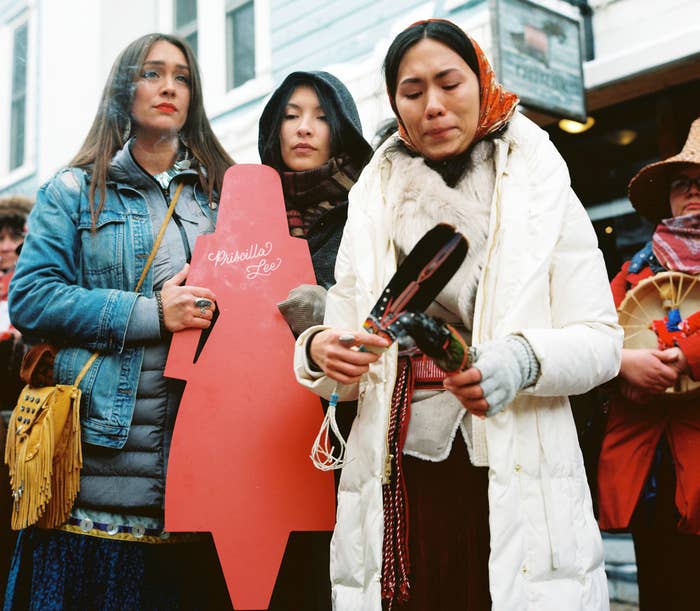
As Women’s Marches took off across the country this month, in some cities the rivers of pink were led by swathes of red: Indigenous women, who donned the color to recognize those who have been murdered or gone missing.
In Seattle, Native people led the march, most accented in red. As they walked, they shouted “Say her name!” and recited the names of victims. In Reno, Indigenous women danced their way out front, again to draw attention to the justice system’s failures. In Portland, Native organizers planned the “Indigenous Womxn's March” after the Portland Women’s March was canceled. Marches across Montana, including in Billings, Missoula, and Kalispell, emphasized Indigenous issues with Native speakers and allies dressed in red.
The movement to bring awareness to Missing and Murdered Indigenous Women has been gaining traction, though non-Natives are still largely unaware. Red skirts, dresses, and scarves have been adopted by the #MMIW movement much as pussy hats have been by other Women’s Marchers. Both colors' movements are working to bring visibility to issues often rendered invisible.
That lack of visibility even extended to the first round of Women’s Marches last year. "We noticed a pattern of invisibility with Indigenous women and women of color,” Eve Reyes-Aguirre, a candidate for US Senate, told the Arizona Republic. But this year, through diverse organizers and dedicated Native women, marches around the country chose to focus on Indigenous voices and the issues we face.
But this focus raises its own challenge: How can organizers amplify Indigenous voices without falling for the tokenization that often accompanies superficial attempts at inclusion?
This was still an issue at the 2018 marches. “I feel like I was there to provide an avenue for white feminists to feel good about the fact that they allowed me space to ‘tell my story’ and that they ‘heard’ me,” said Rosalyn LaPier, from the Blackfeet and Métis people, of her experience at the Missoula Women’s March. Speaking at the rally "made me feel like I was part of a theater of performative listening," she told me.

The theater can extend to how people receive a woman wearing contemporary or traditional Native clothing. “Anytime that I’ve worn my regalia in a non-Native space, I automatically became a spectacle,” Amber Richardson, enrolled Haliwa-Saponi, wrote after attending the 2017 Women’s March on Washington. “People make comments... They ranged from annoying to moderately offensive.”
I had a similar experience at my first march: I was dressed in a Pendleton coat, with ribbons on my braids and beaded earrings, and white attendees frequently asked to take pictures of and with me.
Promoting diverse voices is not a perfect science, and mistakes are inevitable. But the good news is that organizers can easily do better: first by having a diverse membership and leadership, and then by following a few simple principles. Here’s what I recommend:
Encourage a focus on action. “The Resistance” is shifting from being anti-Trump to promoting its own values. Make sure that those policies include actions to benefit Indigenous peoples. "Ally" is a verb, and marches are not the time to applaud one’s “wokeness.”
Acknowledge whose territory you walk on. Land acknowledgements may start with words but should translate to education and action on the part of the audience.
Respect Native speakers and attendees. Honor songs are not “performances,” regalia is not a “costume,” and ceremonies are not for your entertainment pleasure.
Stop fetishizing anguish. The women who share their stories of lost family are publicly cutting open their wounds in the hope that the audience will become aware and act. While I am thankful that Indigenous issues are becoming more recognized, discussing #MMIW is a painful disclosure of emotion. We should recognize this as the burden it is.
Even when Indigenous voices are lifted with perfect clarity, we can’t take results for granted. Will Native speakers baring their souls affect congressional policy? Or will Native women have put their trauma on display just to be photographed and forgotten? Those questions remain to be answered.
In the meantime, you can call your representatives to ask why Congress has not followed Canada’s example and launched an investigation into the epidemic of murdered and missing Indigenous women in the United States. Ask the Department of the Interior why the US is opening sacred lands like Bears Ears to oil companies. And let this administration and your representatives know that Native people aren’t fighting alone.
Mariah Gladstone is a Blackfeet activist based in Montana.
